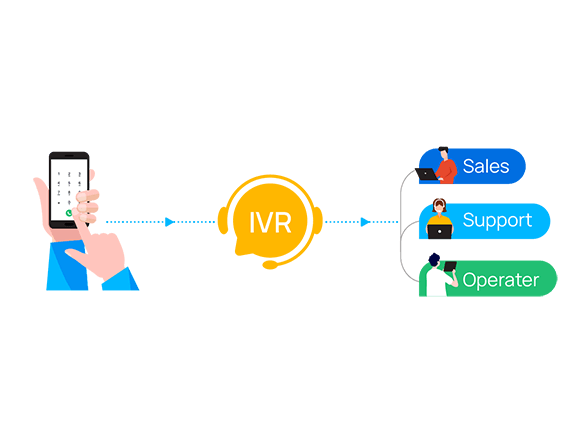Benefits & Definition of Interactive Voice Response (IVR)
IVR stands for Interactive Voice Response.
A phone system feature known as Interactive Voice Response (IVR) enables customers or staff members to communicate with a computer system using voice or touch-tone dialling. Without going through a human operator and taking up their time and your agents, your automated telephony system can engage in essential exchanges with your callers via interactive voice response.
Calls can be efficiently routed to the right person using an IVR system. The IVR can guide customers via a number of menus and alternatives that will direct them to the appropriate department. In this manner, when they do ultimately communicate with a human voice, it will be someone qualified to address their issues.
Why Use an IVR System in a Business?
Traditionally, Customers can contact customer service representatives via phone at a specific customer support number or in person (such as when visiting Apple’s Genius Bar). Customers can rely less on these in-person contacts and more on self-service thanks to the growing popularity of online help resources, such as FAQs or live chat options on a business website.
- Customers will significantly benefit from this. According to a Zendesk survey,
- According to 69% of respondents, they preferred finding solutions on their own without assistance from others.
- Before choosing to contact a company’s customer service hotline, 63% of respondents said they would start by looking for solutions inside its digital channels.
- This study shows two significant trends that you should take into account while creating your call centre:
- Clients prefer self-service. You can accomplish that using an interactive system like Voice Over IP (VoIP), which incorporates Interactive Voice Response technologies.
- The substitution of traditional call sources with digital ones as a first resource To stay relevant, businesses should give priority to digital transformation activities.
What does this mean for your business, then?
The customer experience is crucial when your business handles a lot of incoming calls because of the flow and promptness of your service. Precisely that is what Interactive Voice Response (IVR) can offer. With IVR, call centres can run more efficiently since customer service representatives spend less time routing calls and more time resolving customer issues.
In other words, an IVR aids agents in prioritising consumer demands. Calls can be prioritised based on which customers’ issues are urgent or quickly resolved. The client experience is enhanced, and resolution times are shortened as a result.
What IVR System Functions?
A Conversational Voice, One form of computer-telephony integration, is the response system (CTI). You’ll need a telephony board and specialised IVR software to incorporate IVR technology into your contact centre, which will enable you to pre-record caller greetings. These recordings can be tailored to a caller’s requirements. By doing this, clients will hear a different message while attempting to log into their account than when calling to make a purchase from your business.
These interactive technologies work in a way that lets the end user traverse your contact centre. And find the correct answer quickly. When you phone the business as a customer, the IVR system will react by playing a pre-recorded greeting. And requesting that you select an item from a predetermined menu.
For instance: You will obtain a particular service if you push the number “one” on the keypad.
Customers may now direct their calls to the appropriate parties, which benefits your staff. Overall, this leads to fewer incoming calls, cheaper operating expenses, and higher team member productivity.
The Foundational Skills
A technical description of an interactive voice response system is as follows:
Applications for IVR hardware and telephony
an infrastructure supporting a database
The computer is initially link to the business’s phone line. Then a computer must have IVR software installed on it. In order to use the IVR technology on your calls, a unique piece of hardware (known as a telephony board or telephony card) is require.
Here are some specifics that demonstrate what is necessary for a successful IVR:
the internet network that enables the communication between the Internet and internal networks
Databases: Current data to which IVR applications have access Web/application server: the location of the IVR system’s hosting
It’s crucial to remember that IVR systems require a phone system to function. You should consider selecting suitable call centre software with an IVR function when implementing IVR into your contact centre operations.
Creating an IVR Map
Before integrating an IVR system with your contact centre, you must first map out the IVR script and how it interacts with your customers. The following elements should be present in an interactive voice response map.
testing Your Voice Response, Interactive
It’s time to do pre-launch testing with your internal team after setting up your IVR system. You should test the following regions.


